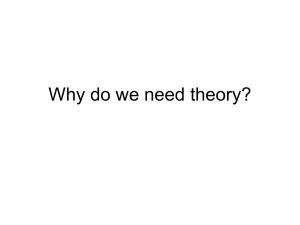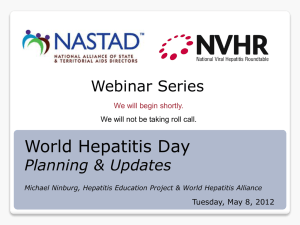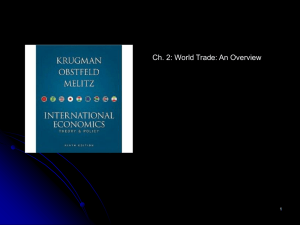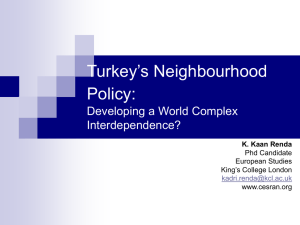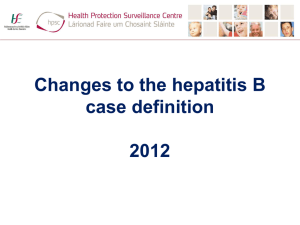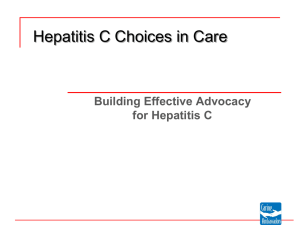PowerPoint Presentation - Effective Practices for
advertisement
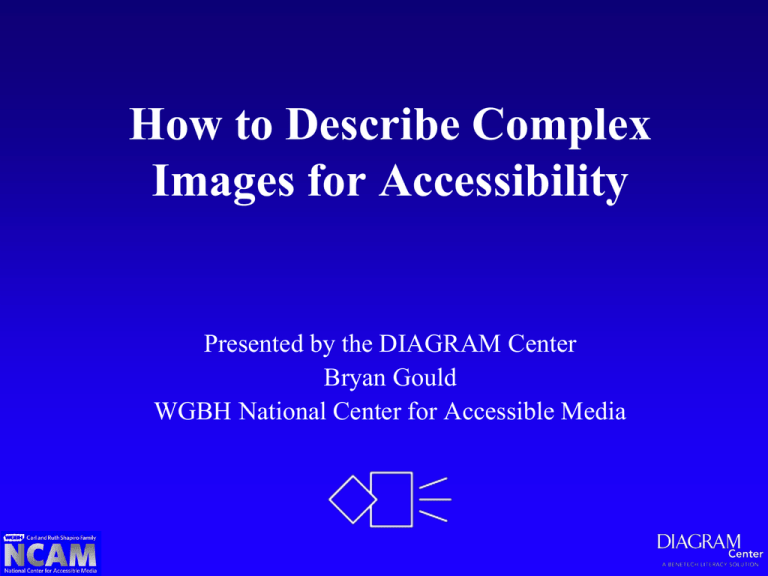
How to Describe Complex Images for Accessibility Presented by the DIAGRAM Center Bryan Gould WGBH National Center for Accessible Media 1. 2. 3. 4. 5. 6. Introduction Describing Complex Images: Guidelines Describing Complex Images: Examples Adding Image Description to Digital Media DIAGRAM Tools & Resources Alternatives: Recorded, Tactile, Haptic & Smart Images Digital Image And Graphic Resources for Accessible Materials • 5-year Research & Development Center • Funded by Department of Education, Office of Special Education Programs (OSEP) • Awarded to Benetech along with partners: • NCAM • U.S. Fund for DAISY (some) DIAGRAM Activities • • • • • • • • • Description guidelines training Product evaluation matrices User survey on reading technologies Report on metadata images SVG and 3D printing evaluation Audio-Tactile usability study POET Standard development: content model Collaboration with Mathematics eText Research Center (MeTRC, U. of Oregon) diagramcenter.org NCAM (est. 1993) Research and Development –develops technical solutions –conducts research –promotes advocacy via outreach –supports national policy decisions Accessible Digital Images iBooks WEBSITES BOOKSHARE ASSESMENTS 2. Describing Complex Images: Guidelines How to Write Descriptions • Be a subject matter expert. • Write well and take care to review spelling, grammar and punctuation. • Monitor length, vocabulary and sentence structure to minimize cognitive load. • Review image in context to ensure the proper tone, structure and vocabulary. • Have access reference materials. • Descriptions should be reviewed by someone who has not seen the image, to ensure clarity and effectiveness. How to Write Descriptions The description author should consider three basic questions about each image in order to give effective and efficient description. 1. Why is the image there? 2. Who is the intended audience? 3. If there is no description what will the viewer miss? STEM Description Guidelines Four years of NSF-funded research produced guidelines for making STEM images accessible. STEM = Science, Technology, Engineering and Math STEM Description Guidelines Brevity Data Clarity Drill-Down Organization Tables, Lists & MathML 3. Describing Complex Images: Examples Parts of a Complex Description: 1. 2. 3. 4. Title Construction of the Image Summary or Overview Data Title The line graph is entitled "FOREIGN TRADE OF COUNTRY X, 1968 through 1980, in United States dollars". Construction There are two lines on the graph, a dashed line labeled "Exports" and a solid line labeled "Imports". The vertical axis is labeled "Billions of Dollars," beginning with zero to eighteen, in increments of 2. Note: one billion equals a one followed by 9 zeros. The horizontal axis is labeled "Year" and lists all the years from 1968 through 1980. Summary The Exports line begins in 1968 at 3 billion dollars, rises steeply, then drops, then shoots up to 15.5 billion, then trails off to 10 billion in 1980. The Imports line begins in 1968 at 2 billion and rises steadily to 8.75 billion in 1980, except for 2 minor dips. Data The data is provided in the following table. Figures are in billions of dollars. All data are approximate. Year Imports Exports 1968 3 2 1969 3 2.3 1970 4 2.4 1971 5 3.1 1972 10 2.5 1973 13 3.3 1974 14.2 3.7 1975 9.7 4 1976 9.5 5 1977 15.5 5.7 1978 12.5 6.3 1979 12 6.3 1980 10.2 8.6 Common Types of Complex Images Straight to Table Straight to List Tons of Info! Tons of Words! Illustrations & Cartoons Straight to Table Table titled, Expanding Education/Decreasing Illiteracy Year School Age Population (5 to 18 Years of Age) Illiteracy (% of total population) 1870 12,000,000 20.0% 1880 15,065,767 17.0% 1890 18,543,201 13.0% 1900 21,404,322 10.7% 1910 24,360,888 7.7% 1920 27,728,788 6.0% Straight to Table / List A bar chart shows funding in billions of dollars per year (2010) • • • • • • • • Marshall Plan (1948-1951), $27 billion Global Environment Facility lending (2009), $1 billion Bill and Melinda Gates Foundation lending (2009), $3 billion World Bank lending (2008), $39 billion Foreign Aid budget of developed economies (2008), $125 billion Millennium Development Goals financing gap (2003), $105 billion Investment needs for universal modern energy (2009), $37 billion UNFCC commitment, $100 billion Straight to List A flow chart titled Adding an article to Wikipedia 1.Search Wikipedia 2.Is it found? • Yes – think of another term and return to Search Wikipedia • No – Is there a related term? • No – Create a new article • Yes – Create a redirect Straight to List? A diagram titled, basic overview of energy and human life. Going in the body: • Chemical energy • Carbohydrates • Fats • Others Inside the body: • ATP • body’s “energy currency” • metabolism Leaving the body: • chemical waste • carbon dioxide • water • heat Unnecessarily Complex! A diagram titled, basic overview of energy and human life. The diagram shows chemical energy (carbohydrates, fats and others) going into a human body. Inside the body are ATP (body’s “energy currency”) and metabolism. Leaving the body are chemical waste (carbon dioxide and water) and heat. Tons of Info! Title Some Little or None Parts of a Complex Description: 1. Title 2. Construction of the Image 3. Summary or Overview 4. Data Much Table Map Title Provide map as separate list. Map of Electoral Votes Democratic: Won all states except those listed below (California was the only state to divide its electoral votes: 2 to Democratic and 11 to Progressive.) Progressive: Washington, South Dakota, Minnesota, Michigan, Pennsylvania. (California: 11 to Progressive and 2 to Democratic.) Republican: Vermont and Utah. Socialist: None States Won All except those listed below WA, SD, MI MN, PA. CA… VT and UT None Alternative approach: add map info to the table as a new column. Break it down into parts 1. Summary of Time Zones 2. Summary of railroads by 1870, in relation to time zones, name key cities and the one transcontinental line (outlier.) 3. Summary of railroads by 1890, in relation to time zones, name key cities. Tons of Words! Break it down into parts 1 2 3 This is a vertical info-graphic, containing a header, footer, and three main sections between them. The header reads, 'FIND OUT IF YOU HAVE HEPATITIS C - IT COULD SAVE YOUR LIFE. SOME PEOPLE DON’T KNOW HOW OR WHEN THEY WERE INFECTED.' The first section below the header reads, "BORN FROM 1945-1965? People born from 1945-1965 are 5X MORE LIKELY TO BE INFECTED WITH HEPATITIS C. 3 OUT OF EVERY 4 people with Hepatitis C were born between these years.' The next section contains a silhouette of a human figure with the liver highlighted. Two text circles connect to the liver with lines. •The text in the first circle reads, 'Up to 75% of people living with Hepatitis C DO NOT KNOW THEY ARE INFECTED.' •The second circle has an hourglass and text that reads, 'Many people can live with HEPATITIS C for DECADES WITH NO SYMPTOMS.' Below the two text circles is a banner across the human silhouette’s abdomen. On the left side of the banner is a small to-do-list with a single item labeled 'Hep C Blood Test'. It is check-marked off. The banner text reads, 'CDC recommends anyone born from 19451965 GET TESTED'. The final section before the footer has two columns, representing a choice of two paths - one, to get Tested; the other column/path, to not get tested. •Under the 'Tested' column, text reads, 'KNOWING YOU HAVE HEPATITIS C can help you make important decisions about your health. Many people can get LIFESAVING CARE AND TREATMENT. Successful treatments can ELIMINATE THE VIRUS from the body.' •Under the 'Not Tested' column, the text reads, '60% of people with HEPATITIS C will develop SERIOUS LIVER PROBLEMS. Left untreated, HEPATITIS C can cause LIVER DAMAGE & LIVER FAILURE. HEPATITIS C is a leading cause of LIVER CANCER. The footer has the logos for CDC-HHS and Know More Hepatitis on the right-hand side and text on the left that reads, 'Don’t go down the wrong path, talk to your doctor about getting tested. It could save your life. Break it down into parts Illustrations & Cartoons Summarize! Mostly blue and green Mostly orange and red Context Requires specific description detail. Cartoons 1. 2. 3. 4. Setting Characters Details as needed Caption Data Visualization 4. Adding Image Description to Digital Media Adding Image Description HTML & EPUB • alt • longdesc • ARIA (W3C) contains several imagedescription properties DTB • alt • prodnote Adding Image Description PDF • figure tag (text only, no markup) MS Word • alternative text within image properties InDesign • alternative text 5. DIAGRAM Center Tools & Resources DIAGRAM’s POET http://www.youtube.com/user/diagramc DIAGRAM’s Content Model Content Model: Container for Additional Information Multiple Alternative Elements • short description • long description • SVG reference • description of SVG, tactile • simplified description • alternative image • alternative image description Content Model: Container for Additional Information • • • • • Metadata purpose, age/grade level links to specific image description repositories quality rating concept (of the image) version of content model 6. Alternatives: Recorded, Read Live, Tactile, Haptic, and Smart Images Recorded Narration or Read Live Parts of a Complex Description: 1. Title 2. Construction of the Image 3. Summary or Overview 4. Data Title The figure is entitled "FOREIGN TRADE OF COUNTRY X, 1968 through 1980, in United States dollars". Construction There are two lines on the graph, a dashed line labeled "Exports" and a solid line labeled "Imports". The vertical axis is labeled "Billions of Dollars," beginning with zero to eighteen, in increments of 2. Note: one billion equals a one followed by 9 zeros. The horizontal axis is labeled "Year" and lists all the years from 1968 through 1980. Summary In the graph, the Exports line begins in 1968 at 3 billion dollars, rises steeply to 14 billion in 1974, then drops to 9.5 billion in 1975 and 1976. In 1977, the Exports line shoots up to 15.5 billion, then trails off to 10 billion in 1980. In the graph, the Imports line begins in 1968 at 2 billion and rises steadily to 8.75 billion in 1980, except for minor dips in 1972 and 1979. Data The year is followed by imports in billions of dollars and then exports in billions of dollars. •1968, 3, 2 •1969, 3, 2.3 Read Just Like the Table •1970, 4, 2.4 •1971, 5, 3.1 •…continued Tactile Enhanced Tactile Manipulatives 3D Printers Haptic Smart Images Vibration! Contact Information Bryan Gould WGBH National Center for Accessible Media bryan_gould@wgbh.org DIAGRAM Center Funded by Department of Education, Office of Special Education Programs (OSEP) diagramcenter.org

